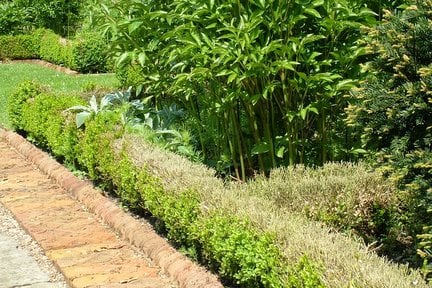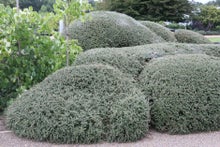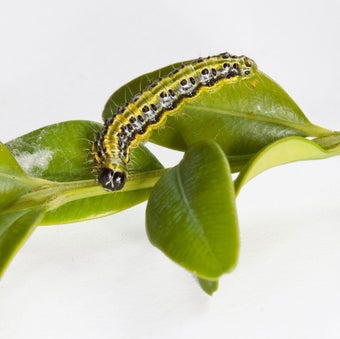
Quick facts
Box blight doesn't kill roots so diseased plants don't necessarily have to be dug out
The fungus survives in infected leaves, stems and residues
Box blight develops and spreads more under wet conditions
Spores can remain viable on fallen leaf litter for at least 6 years
Strategies to manage box blight outbreaks
Your chances of success in managing box blight will be enhanced by using a combination of strategies, but they should be used in a co-ordinated way. The measures should suit the outbreak and be practical in your garden. Box blight management is labour intensive. You may want to prioritise your efforts to protect the most valuable or cherished specimens.
Box blight doesn't kill the roots of box plants so in theory they can recover if cut back. Fortunately, box responds well to clipping (which is why it is such a good hedge and topiary plant) and will also respond to box blight by producing new shoots. The risk is that the new ones will also become infected.
Management focuses on removing sources of infection, protecting uninfected and new growth and managing for healthy recovery. Doing nothing seldom works in the long term.
Step 1: Review garden hygiene
These measures are targeted to manage a box blight outbreak, but are worth considering for good general ;
- Bag up and dispose of infected material to avoid dropping debris around the garden. Do not
- Clean pruning tools (for instance, with a garden disinfectant such as Jeyes Fluid or a dilute bleach solution) and clean clothing after working in infected areas
- Check soles of shoes for leaves and soil; brush any off and clean them as for tools to remove adhering spores
- Applying a fungicide (see section below) prior to cutting back infected plants may reduce the risk of spore development and spread during and immediately after cutting
- Remember to quarantine new plants if replacing with more box in the garden
Step 2: Control the infection
The box blight fungi (Calonectria pseudonaviculata and C. henricotiae) survive and reproduce in infected leaves and stems, including fallen leaves and dead stems. Fungal spores within these infected tissues act as pockets of the disease (i.e. the inoculum) that can invade previously uninfected leaves and stems.
Infection has probably progressed further than it shows, so it pays to cut out more than you think you need to. It is important to cut out infection when the disease strikes, even if it is not the normal time of year to trim box. However, if the plants are wet such as after rain, wait until conditions are dry before beginning cutting back, otherwise you risk spreading the disease further.
Cutting back or cutting out
Removing some or all of the affected areas will reduce the amount of inoculum and improve the chances of healthy recovery. Prioritise your plantings; removing infected, less important, plantings may safeguard prized plantings.
How can I tell what is diseased? Typically you are looking for patches on your box plants where the leaves have gone brown or have fallen, leaving bare stems. Infected stems will have distinctive black streaks and dieback (i.e. are no longer green under the ). For more on symptoms and photos of the disease see our page on box blight.
Choose from one of four options, depending on the severity of the infection and your priority;
Option 1: remove minor or isolated infections
(Good where infections have been detected early, for topiary specimens, or where fungicides will be applied.)
- Cut out a little more than you think is necessary as some infections are likely to be latent (not yet visible)
- Do not touch healthy box plants immediately after working on an infected area
- Consider applying a fungicide (see below) before cutting and again after two weeks
Option 2: reduce height by about a half
(Good for hedges and parterres. Also where infection is spread over large areas. This approach creates a more open structure in the plants that discourages box blight.)
- Try to cut stems so no black streaks remain. This may require reducing width as well as height
- Consider applying a fungicide (see below) before cutting and again after two weeks. Reduction can be less severe if you intend to use fungicides
- Clean pruning tools regularly during process
Option 3: cut back to stumps
(Good where infection is severe but is in a position where you want to try to save the box feature (e.g. part of a parterre) or where you do not wish to apply fungicides. This more drastic approach aims is to remove all infected tissues to maximise the chances of removing all inoculum.)
- Cut back all plants showing symptoms to ground level, leaving just the stumps
- Plants can be cut back at any time, but beware of the risks of transporting the pathogen around the garden in wet conditions
Option 4: remove affected plants
(Good where infection is very severe, the box is not of high value, or it threatens other box plantings.)
- Remove plants at any time, but beware of the risks of transporting the pathogen around the garden in wet conditions
- Avoid planting box in the same place for several years (spores can remain viable on fallen leaf litter for at least 6 years)
Fed up with damage to your box plants? There are plenty of good alternatives that lend themselves similarly well to clipping. Read our guide to choosing box alternatives, and then browse our box alternatives selection page to find a plant that works for you.
Remove fallen leaves and infested soil
- Lay down a tarpaulin or sheeting before clipping, to make clearing up clippings and debris easier
- Remove dislodged leaves and other debris from the canopy after cutting back
- Clear away as many fallen leaves from under and around the plants as possible (even a few remaining leaves can lead to new infections)
- Remove a layer of soil under the plants to get rid of infected leaf fragments. Replace with fresh soil (do not overfill)
- Apply a mulch
Disposing of diseased material
For ways of getting rid of infected clippings, leaf litter or entire plants, see our page on disposing of diseased material.
Fungicides
The RHS recommends that wherever possible you don't use fungicides. Fungicides (including organic types) may reduce , impact soil health and have wider adverse environmental effects. If you do intend to use a fungicide, please read the information given in the link and download below to ensure that use, storage and disposal of the product is done in a responsible and legally compliant manner.
The products listed in the ‘Fungicides for gardeners’ document below are legally available for use by home gardeners in the UK. This information is provided to avoid misuse of legal products and the use of unauthorised and untested products, which potentially has more serious consequences for the environment and wildlife than when products are used legally. Homemade products are not recommended as they are unregulated and usually untested.
Download
Fungicides for gardeners (Adobe Acrobat pdf document outlining fungicides available to gardeners)
Link
Chemicals: storing and disposing safely

Step 3: Promote recovery
If plants have been removed, it is best not to plant box in the same place. Remaining box plants should be kept as healthy as possible to promote regrowth after cutting back. Deal speedily with any further outbreaks. Re-visit the tips in box blight: keeping it out.
The environment
- Consider whether the design of the garden is optimal. Alternative plants may be preferable in high risk areas
- Try to create an open environment – avoid overhanging plants (e.g. next to a parterre) or plants that crowd around the sides of a box hedge
- Avoid overhead watering if possible (leaves will be drier with trickle irrigation)
- Apply a mulch to reduce rain splash as well as to cover any infected leaves you may have missed
- Revert to standard pruning times for box. Clip in dry weather where possible to avoid spreading undetected infections
Plant nutrition
- Apply a fertiliser (general-purpose or one developed for box) in spring or summer to help plants recover from the stress of leaf loss
- Avoid applying too much nitrogen (e.g. sulphate of ammonia or chicken pellets) as this can lead to dense lush growth that provides an ideal microclimate for box blight to develop
Fungicides
Even if you are prepared to use garden fungicides, they are unlikely to be successful as the sole strategy for managing box blight outbreaks. Pruning out and removing infected leaf litter (including soil contaminated with it) are equally important.
How to use fungicides to manage box blight effectively:
- Apply prior to cutting out infected areas to minimise spread of live box blight spores
- Apply after cutting at, and adjacent to, sites of infection to clear up latent infections and protect new and uninfected growth
- Apply to new growth in risk areas, but try to combine with monitoring for re-infection
Step 4: Monitor for new infections
Unfortunately, it is unlikely that you will be lucky enough to eliminate box blight in your first attempt, so it will be important to monitor the plants. Try to detect new infections early and deal with them promptly. Box blight damage is cyclical. You may think you have dealt with an infection in spring, only to have it develop again in damp summer or autumn weather.
- Check previously infected areas regularly, but also monitor other areas in case infection has spread
- Inspect more closely at any patches, even if they only initially look a little yellow. It may turn out not to be box blight but there are other problems box can suffer from so best to check
- Record observations and treatments to help refine your management strategy










